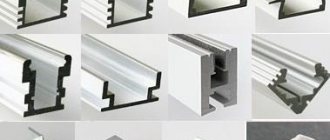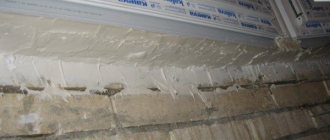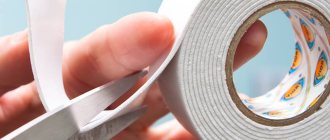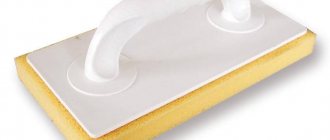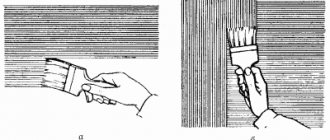Material properties
The main advantage of fluoroplastic is its high plasticity.
In addition, the material is durable, non-toxic, chemically inert, and thermally resistant. FUM tape is capable of operating at pressures up to 40 MPa (relevant for antler baths).
The temperature range is minus 60 – plus 200 degrees.
When heated above 260 degrees, the structure of the material begins to deteriorate, and highly volatile fluoride compounds are released.
Average material characteristics:
- thickness 0.04 - 0.2 millimeters;
- width – 10, 15, 20, 60 millimeters;
- fracture tension 40 – 60 kg/cm2;
- lubricant content 0.3 – 20%;
- 100% elongation before breaking.
Isn't it better to use oakum?
Tow began to be used by plumbers long before the advent of newer sealing materials. This is precisely what the age-old question is connected with: linen or fum tape, which is better? And although the first option has been tested by generations of installers, it has a significant drawback - you will need skills to work with tow correctly. Fum materials do not require special skills.
Each flax fiber must be separated and straightened. Once laid, the threads cannot intersect. And the amount of tow must be correctly determined; both an excess and a lack of it will lead to the fact that the joint will begin to “tear.” It’s also worth remembering about the layer of sealant that will have to be applied on top with a brush. In general, it’s not for nothing that many have switched to fum!
Each flax fiber must be separated and straightened. Once laid, the threads cannot intersect. And the amount of tow must be correctly determined; both an excess and a lack of it will lead to the fact that the joint will begin to “tear.” It’s also worth remembering about the layer of sealant that will have to be applied on top with a brush. In general, it’s not for nothing that many have switched to fum!
If you still don’t understand how to wind fum tape, the video instructions will definitely help you understand this issue. Happy installation!
FUM1 tape is used to seal threaded connections. It is made from fluoroplastic grade 4D - a synthetic material; a thin elastic white tape is obtained by rolling out a rope. Most often it is used to seal pipeline connections. In this article we will look at how to wrap fum tape around a thread for a strong connection.
Also, read about alternative types of sealants: tangit-unilock and plumbing tow.
Characteristics of fum tape of three types
- FUM tape is produced in three types, depending on the place of its application. FUM tape grade 1 is a premium grade tape designed for sealing threaded connections in systems with an aggressive environment, for example, concentrated alkali or acid. This tape contains Vaseline lubricant, which increases its performance characteristics.
- Grade 2 tape is typically used to seal piping systems that handle strong oxidizing agents such as oxygen and does not contain the protective lubricant of petroleum jelly.
- FUM grade 3 is used in general type pipeline systems, but it can also be used in systems with potent agents. When using a tape of this brand, you should know that this type of tape is less reliable than the previous FUM brands 1 and 2.
To a large extent, the connection density depends on the correct winding of the FUM. How to wind fum tape onto a thread correctly, avoiding leaks?
Correct winding of fum tape onto the thread
First, clean the threads of dirt and rust before wrapping the fum tape. Then all parts of the pipeline should be wiped with solvent or gasoline. The FUM tape must be wound along the thread with careful movements.
Each turn of the FUM tape should partially cover the previous one. To prevent folds and wrinkles from forming on the tape and to ensure that it is wound smoothly, winding should be done with a slight tension.
We should not forget that the smoother the tape is wound, the more reliable the threaded connection will be. There is no need to move the roll of tape away from the winding point too much - the best option is when it fits closely to the thread.
When the tape is wound, you can screw the butt piece to the joint. When screwing, it must move with a certain force - at this moment the FUM tape fills the thread. For clarity, watch the video:
Where is it used?
Due to its properties and characteristics, FUM tape is used in most situations where sealing treatment is required.
- Water pipes . The most important thing that FUM tape is used for is sealing water connections. The material is water-repellent, which makes it almost indispensable for fastening water pipes and parts during the assembly and installation of equipment.
- Gas pipeline . The film can be made gas-tight, and it can be used to install gas appliances and meters. However, not every FUM tape is suitable for this purpose; you need to purchase a specialized tape for gas.
- Technique . The material is characterized by resistance to various types of influences, therefore it is actively used to repair internal mechanisms of cars and various technical devices.
Heating pipes fastened with tape Source re-st.ru
Precautionary measures
- It is not recommended to wind the seal using two or more pieces - this will compromise the tightness and strength of the connection.
- The tape on the thread should not be partially unwound, since if it is applied again, the connection will lose reliability. If winding is unsuccessful, the material should be removed completely and the process repeated.
- If, when connecting the elements, too much tension is created, which can lead to breakage, the tape will not be loosened. In this case, you also need to apply the seal again, removing the old section.
FUM tape is a material that is sufficiently reliable when sealing threaded connections. Its correct use will ensure the tightness of any pipeline even for a person who does not have extensive experience in plumbing work.
Sequence of winding fum tape
For those who want to learn how to wind fum tape correctly, there is a certain algorithm of actions, the implementation of which will ensure a reliable connection:
- First of all, you need to select the desired width and thickness of the tape. For example, if parts of the water supply system have significant wear, then the tape must be selected with a greater thickness, up to 0.2 mm.
- Next, you need to thoroughly clean the parts being joined so that there are no residues left from previous tapes, tow, paint, rust residues, etc.
- Then you should carefully wind the tape onto the part with a smaller diameter, that is, on the one that will be screwed in (or onto which the second element of the threaded connection will be screwed).
- You need to wind the tape strictly clockwise, since according to our standards, almost all threaded connections (in general, everything in plumbing) have a right-hand thread. This is done so that when screwing the joining parts, the fum tape does not fold, but continues to wind together with the part. Understanding how to properly wind fum tape is quite simple. If you want, you can learn this in 30 minutes.
Using these basic rules, you will easily understand how to properly wind fum tape for threaded water pipe connections
It is worth paying special attention to the fact that the tightening force must be selected carefully. This is especially true for water supply parts made of bronze and other soft metals and alloys
The main thing is not to over-tighten! The final result depends on how to wind the fum tape correctly. The main parameter here is the skill of the repairman, but for beginners it is enough to simply tighten it without putting much effort. After starting the water, you need to check the connection and tighten it if necessary. If the water is still leaking, and tightening it further is risky, then you need to turn off the water, unscrew the connection and add a couple of turns of the tape.
Varieties, alternatives and selection rules
Flax is good for laying almost all metal pipes, including cast iron, stainless steel, non-ferrous metals, including copper, and their alloys, such as brass. The only exceptions are aluminum and metal-plastic products, as well as those made from polymer compositions. For them, professionals recommend using fum tape.
Fibers of various qualities are available on sale. All of them are produced on the same equipment - a carding machine. They are distinguished by numbers, which contain a description on the label. They vary in the range from 8 to 24. In this case, fibers with a higher number will have fewer impurities and vice versa. They are also characterized by a degree of flexibility, which is less important in their work.
Fibers are packaged in coils, as well as braids of fixed weight and size. Their color can vary from white to light gray, as well as beige due to the use of natural raw materials.
What is tow and how to work with it
Before fum tape appeared on the market, plumbing tow, which was flax fibers, was used to seal threaded connections of pipes. Optimal results were achieved by coating the layer of tow wound on the thread with a small amount of oil paint. Such a connection was difficult to disassemble after several years.
Now sanitary linen in the form of long silky threads is used along with new sealing materials. Only now a layer of sealing paste is applied on top of the winding, ensuring a reliable and durable connection. The paste protects the flax from rotting and makes dismantling easier if necessary.
Flax fibers are long, thin, strong, fit tightly into the grooves of the thread and do not deform when screwed
Flax paste effectiveness of the old method
Plumbing flax (or tow) was actively used in the Soviet years, but has not lost its popularity today, despite the wide variety of modern seals. To seal threaded connections, strands of flax were used in combination with red lead on drying oil or special oil paint. The main active ingredient of both formulations is lead. It is rarely found in modern analogues, and the sealant itself is not able to fully combat corrosion.
As an alternative, gray sealing pastes are used. Dry winding is strictly prohibited. The paste prevents flax from rotting and drying out, and plays an important role in water. Without its use on threaded connections with hot water and heating, the flax strand dries out, crumbles, and leaks appear. A black coating with traces of corrosion will form on the surface of the cold water pipeline and a leak will occur.
In direct contact with water temperatures above 90°C, tow shrinks and loses its properties, which is why it is so important to cover it with paste in order to increase the temperature barrier and the service life of the seal.
When choosing a high-quality material for sealing threaded connections, experts recommend choosing Unigarn flax and Unipak sealing paste. This seal can be easily dismantled and replaced if necessary.
Here are the main advantages of using sanitary flax with paste for hot water taps:
- 1. Possibility of winding on pipes of any design and diameter.
- 2. Winding on dirty, wet and old surfaces.
- 3. Adjustment (regulation) of connections at 45° and higher.
- 4. Ability to withstand temperatures up to 140°C, used for heating systems.
- 5. Long service life if the correct winding technique is followed.
- 6. Cheap material. The price of 100 g of flax does not exceed 100 rubles, a good paste costs 200–250 rubles. For home use, such a kit is enough for a large number of connections.
It is also necessary to remember that flax is a natural material, it does not contain harmful impurities, and is suitable for connecting threaded connections with drinking water.
The material also has its disadvantages:
- the paste stains your hands and leaves marks on white propylene pipes;
- inconvenient for winding on plastic and small threads;
- flax fibers get tangled and create inconvenience when working.
Working with plumbing flax requires skill and knowledge. The main thing is to attract the tow well, hide the ends of the strands, ensure complete closure of the threaded connection and do not skimp on the sealing paste.
How to wind tow on a thread
To prevent the flax from sliding along the thread, there are notches on it.
Impregnation of flax with a special paste, coupled with proper winding, guarantees that the connection will last a long time
For winding, a small strand of flax is separated. The length and thickness of the “strand” are determined visually depending on the diameter of the pipe. The winding is done as tightly as possible, the threads are directed along the thread, the free end of the tow is fixed with a finger, and after a couple of turns it is brought into the guide strand. The tightness of the connection is ensured by the optimal layer thickness. It is quite difficult to calculate the density: you need experience and a certain “plumbing” eye.
Proper Use
FUM tape can provide reliable connection protection even when used by a non-specialist.
Knowing some of the features will help in creating a sealed connection (watch a video of alternative heating of a private house with your own hands on this page).
In turn, this will save you from the troubles associated with sudden leaks in the pipeline.
The following sequence of actions must be performed:
- the threaded connection is cleaned of debris and rust;
- parts included in the connection are degreased with gasoline or solvent;
- the material is wound onto the external thread in a clockwise direction. It is imperative to give the tape a slight tension, at which the fluoroplastic fits tightly to the thread;
- the end of the tape is brought out in such a way as not to interfere with the element being wound.
FUM tape is wound in several layers to create a tighter connection.
The number of turns depends on the diameter of the pipes (for water supply in an apartment).
When using products with a diameter of 15 - 25 millimeters, three full turns of the seal will be enough. As the size increases, more layers of fluoroplastic are wound.
To the touch, FUM tape is slippery and can cause inconvenience when working. The wound seal cannot be reused.
How to wind it correctly and how many turns of FUM tape you need to make on the thread, watch the video.
FUM1 tape is used to seal threaded connections. It is made from fluoroplastic grade 4D - a synthetic material; a thin elastic white tape is obtained by rolling out a rope. Most often it is used to seal pipeline connections. In this article we will look at how to wrap fum tape around a thread for a strong connection.
Also, read about alternative types of sealants: tangit-unilock and plumbing tow.
Characteristics of fum tape of three types
- FUM tape is produced in three types, depending on the place of its application. FUM tape grade 1 is a premium grade tape designed for sealing threaded connections in systems with an aggressive environment, for example, concentrated alkali or acid. This tape contains Vaseline lubricant, which increases its performance characteristics.
- Grade 2 tape is typically used to seal piping systems that handle strong oxidizing agents such as oxygen and does not contain the protective lubricant of petroleum jelly.
- FUM grade 3 is used in general type pipeline systems, but it can also be used in systems with potent agents. When using a tape of this brand, you should know that this type of tape is less reliable than the previous FUM brands 1 and 2.
To a large extent, the connection density depends on the correct winding of the FUM. How to wind fum tape onto a thread correctly, avoiding leaks?
Correct winding of fum tape onto the thread
First, clean the threads of dirt and rust before wrapping the fum tape. Then all parts of the pipeline should be wiped with solvent or gasoline. The FUM tape must be wound along the thread with careful movements.
Each turn of the FUM tape should partially cover the previous one. To prevent folds and wrinkles from forming on the tape and to ensure that it is wound smoothly, winding should be done with a slight tension.
We should not forget that the smoother the tape is wound, the more reliable the threaded connection will be. There is no need to move the roll of tape away from the winding point too much - the best option is when it fits closely to the thread.
When the tape is wound, you can screw the butt piece to the joint. When screwing, it must move with a certain force - at this moment the FUM tape fills the thread. For clarity, watch the video:
Product marking
The technical regulations define three markings for fluoroplastic sealants.
The remaining products are subtypes of the main names:
- FUM-1.
It is used as a sealant in general pipelines, in systems working with aggressive chemicals (calgon analogues for washing machines are written about in this article). Added lubricant to the composition – 20% petroleum jelly; - FUM-2. The material is used in pipelines containing substances with strong oxidizing properties. Lubricant is not included;
- FUM-3. Tape is used in communications with neutral media. Available without lubrication.
IMPORTANT! The material is destroyed at temperatures above 520 degrees. Doesn't burn, doesn't explode
Manufacturers guarantee shelf life within 10-13 years.
What to remember
The surface of the material is quite slippery, which can make repairing damage difficult.
Once the connection is sealed, there is no need to unwind the tape back. If it was applied incorrectly, it is necessary to completely peel off the product and rewind it.
If the tape tension is too high
, it must be removed from the thread and a new layer wound.
Fum tape is an excellent material that is used to seal various joints. In order for the product to provide excellent results, it is necessary to choose the right variety, as well as learn how to wind the tape in accordance with all requirements.
When performing installation work, it is often necessary to seal connections
This is important when laying water supply or gas distribution systems. In years past, flax fibers were commonly used for this purpose.
Nowadays, fluoroplastic fum tape is increasingly used as a sealing and sealing material. Below we will discuss the technical characteristics of fum tape, indications for use, and features of its correct use.
Despite the unfamiliar name, many of us know fum tape very well, and most people actively use it in everyday life, calling it silicone tape. Let's take a closer look at what it is, where and when fum tape is used, and how to use it correctly.
In fact, this product is made from fluoroplastic (PTFE-4), which has excellent sealing and heat-resistant characteristics. The tape is produced in the form of white or transparent strips wound into rolls. The width of the tape is 1-1.6 cm. Some types of tape may additionally have a lubricant or a layer of adhesive.
The scope of application of fum tape is quite diverse. With its help, they achieve sealing of almost any detachable connections: threaded, nipple, flanged. It is used in many engineering systems, the operating pressure of which does not exceed 9.8 MPa. In everyday life, it is used for the installation of metal, plastic and metal-plastic water supply systems, when connecting plumbing fixtures, and installation. Fum tape also provides sealing of country irrigation systems.
Fum tape for plumbing has its own symbol, which reflects its brand, length per roll, width and thickness. For example, a designation such as: “FUM 12m x 12mm x 0.1mm” can be deciphered as follows: “Tape 12 m long, 12 mm wide, 0.1 mm thick.”
A little history
The material from which the tape is made was accidentally discovered by American engineer Roy J. Plunkett in 1938, while working for DuPont. It was registered under the Teflon trademark.
By 1948, more than 900 tons of fluoroplastic were produced. It was used at a uranium enrichment plant to insulate valves and joints in pipes. In 1954 they began to use it “for peaceful purposes.” The first Teflon-coated pans appeared (Tefal brand).
And in 1969, Robert Gore joined the research. He worked for W. L. Gore & Associates, owned by his father. The company received an order to create a new composition for plumbing purposes. Experiments began.
It took Robert a long time to make a thin elastic tape from a PTFE bundle - it broke. But Gore Jr. did not give up. He stretched the tourniquet in various ways. One of them (stretching with a jerk) gave an unexpected result. PTFE expanded 8 times to form a finely porous structure consisting of 70% air.
Thanks to this invention, not only FUM appeared in our lives, but also waterproof fabrics for clothing, sports shoes, medical implants and waterproof laminate.
Which is better linen or fum tape for water?
A professional plumber always has different types of seals on hand:
- fum tape;
- flax and sanitary paste;
- threads (type “Tangit”);
- anaerobic sealant.
The craftsmen know that all seals, when installed correctly, perform their task 100%. But to do this you need to know how to use it, what to use and under what circumstances. The abundance of modern sealing materials has displaced flax from its leading position. But not all masters agree with this.
The fact is that in past decades flax was used together with red lead or oil paint. Today – with Unipak plumbing sealing paste. Its main task is to prevent the flax from drying out and rotting. Connections made using these materials can be adjusted (axially shifted) by 45° without loss of tightness.
Benefits of flax:
- inexpensive price;
- suitable for sealing threads of any diameter;
- the connection will be good regardless of whether the base surface is wet or dirty.
The disadvantage is that any connection made with flax subsequently requires additional twisting and tightening. Another “minus” of flax is that it is not very convenient to work with: the fibers delaminate and cling to clothing and the tools and materials used.
If you compare flax and fum tape, the latter loses in that it does not allow you to adjust the connections without losing the tightness. That is, if you need to slightly turn an already tightened fitting, leaks may form in this place.
Cold and hot water
BUT wait, why use tape or thread then? Why were they created at all? It's simple - they are perfect for waterways. Where there is a constant temperature.
For example, for cold water. Where there is no thermal expansion and then cooling, there are no high temperatures. It seals just fine.
For hot water you need to think about it. It is clear that the pipes are almost always heated; they are hot in one position. No one will turn them down, the temperature is also constant - THIS IS A PLUS. BUT, the water may be turned off for a while, for example, during seasonal testing, then the pipes may also cool down and leaks may appear at the joints. Also, over time, FUM seals can dry out, as happened to me.
Now we are watching a useful video.
EVENTUALLY. Where there are no high temperatures, no expansion of metals, FUM can and even should be used, it’s an excellent means. For heating and hot water, I would advise you to use Paklya with sealing paste, it has been working for decades.
This is where I end, I think my materials were useful to you. Read our construction site.
Comparison of fluoroplastic and flax
Along with synthetics, sanitary flax fiber is still used (which is better, FUM tape or flax).
The material is produced from flax processing waste. Tow is used together with silicone sealant or oil paint to insulate threaded connections.
The use of natural material is a proven method that guarantees 100% tightness.
Plumbers' refusal of flax is due to difficulties in use (how to install a tulip sink in a bathroom is written here).
To properly seal a connection with plumbing flax, you must have certain skills.
Synthetic fluoroplastic does not require this. It can be used without any preparation.
Before winding, the tow fibers are evenly separated.
When applied to threads, skipping turns, twisting of fibers, and overlaps are not allowed.
Then an adhesive sealant is applied to the tow (read what is needed for polypropylene in this article).
Incorrect or insufficient application of flax will result in a poor-quality connection and leakage.
Excess material leads to an overly tight connection, the excess material is cut off with metal coils.
This leads to an increase in stress in the connected parts.
The result will be complete or partial destruction of parts.
Determining the right amount of flax comes with experience.
Working with cast iron threaded fittings and steel products of large diameters does not require professional skills.
It is most effective to use FUM tape for water when connecting metal-plastic or polymer pipes.
FUM tape will not provide a guaranteed seal when working with old metal pipes. In this case, tow with silicone sealant is used.
Advantages and disadvantages
The advantages of the winding include:
- The first difference from tow is that fumlenta does not absorb water. Therefore, the joining does not require additional sealing in the form of paint or putty;
- Ease of use - the seal is packaged in small reels, from which it is easy to screw directly onto the thread;
- Aesthetic processing - the material does not protrude beyond the edges, as happens with tow. In addition, the tape is produced in colors that match the colors of plastic pipes and blends into the general background;
- Linen tow becomes unusable over time and requires replacement, but fluoroplastic does not collapse and lasts as long as a fitting or siphon;
- Easy dismantling in case of replacement of the structure. The winding is simply removed without additional stripping;
- After winding the seal, no significant effort is required to connect the parts;
- Widespread - it can always be purchased in several widths and thicknesses in any construction market.
There are minor disadvantages:
- Not suitable for triangular metal steel threads, as the material may be damaged by sharp edges and will not function as a sealant;
- The excess winding is not compacted like traditional tow, so you need to dose the winding turns. Usually this is 3-10 revolutions;
- The seal is not suitable for equipment that produces vibration during operation. During operation, shaking deprives the fluoroplastic of its inherent properties, breaking the tightness.
Anaerobic gel sealants sanitary gel
Another modern material for sealing pipe threads is sanitary gel. Reliable compaction occurs due to the polymer component of the gel. After hardening, sanitary gel does not shrink or expand, is resistant to temperature changes (from -60 to +150) and pressure surges, and has proven itself in various environments: water, natural and liquefied gas, heating antifreeze.
How to seal a plumbing connection: flax, fum tape, anaerobic sealant - a specialist decides
Sanitary gel is produced in three types:
- In green tubes - easy dismantling.
- In blue - medium dismantling.
- In red (Stop Master Gel) – dismantling with heating.
Installation using sanitary gel is simple: shake the tube and apply the gel in a thick layer around the entire circumference of the thread, distribute it evenly (with a brush, a special spatula), and assemble the structure. Excess gel is removed with a rag. Polymerization of the gel occurs in 15–20 minutes.
Fum tape what is it
PTFE sealing material, or fum tape for short, is a polytetrafluoroethylene film used to seal pipe joints. It is made by rolling out a fluoroplastic rope to the required thickness. The sealant is produced in the form of a tape of a certain size, wound on a reel (similar to electrical tape). Used when installing systems under pressure: water supply, gas supply, central heating. The material functions as a deformable filler and at the same time as a thread lubricant, which improves the sealing of connections.
Types of fum tape:
- fum-1 – designed for sealing pipelines working with aggressive media. Contains lubricant – purified petroleum jelly;
- fum-2 - used in systems in contact with strong oxidizing agents, therefore it is not impregnated with lubricant;
- fum-3 - used in systems working with clean media. Does not contain lubricant.
Plumbing tape fum also varies in size: thickness ranges from 0.075 to 0.25 mm; width starts from 10 mm; length from 1000 mm.
They produce a special yellow gas fum tape with a thickness of 0.15-0.25 mm. For gas pipes operating under low pressure, the use of ordinary plumbing tape is allowed.
Special gas fum tape is denser than conventional plumbing tape
Technical characteristics and properties of fum tape
Main properties of PTFE:
- Low coefficient of friction. Fluorinated plastic polymers (PTFE) have a very low coefficient of friction - they are slippery, which makes it easier to connect fittings. They act as a kind of gasket for pipe threads, improving fit and sealing.
- Heat resistance. PTFE has an extremely high melting point for a plastic - 327 degrees. They are designed for use at temperatures up to 260 degrees (when heated above, they release toxic fluoride compounds). PTFE is an excellent dielectric (electrical insulator), which is an added benefit.
- Plasticity and strength. Resistant to mechanical stress. They operate at a constant pressure of up to 10 MPa and withstand differences of up to 41 MPa. Average service life is 13 years. Prolonged exposure to light slightly degrades properties.
- Chemical and biological inertness. They are highly resistant to acids and alkalis. There is no solvent for PTFE yet. The polymers are uniformly coated with fluorine atoms, which makes the material inert to almost all chemicals. Decomposition is possible only under extreme conditions created in special laboratories. Not subject to rotting.
The ductility of PTFE allows the plumbing tape to stretch and fit tightly around the threads
Specifications
Let's consider the technical characteristics of the FUM tape, which determine its properties:
- the material is characterized by resistance to damage;
- has plasticity;
- retains its properties for a long time and does not need regular replacement;
- is environmentally friendly and does not emit harmful substances;
- heat-resistant, able to withstand a wide range of temperatures;
- the thickness is only two tenths of a millimeter;
- has dielectric properties and gas impermeability;
- elastic, capable of stretching almost twice its original length.
What is better tow or fum tape
Each material has its own advantages and disadvantages. Plumbing flax is used to seal joints of steel pipes (especially rusty and/or large diameter ones).
Advantages of tow:
- the ability to adjust the connection: unscrewing back by 45 degrees is permissible;
- reliable tightness: absorbs moisture well;
- resistance to mechanical stress;
- easy dismantling of the connection.
The disadvantage is the tendency to rot/decompose, since tow is a natural material.
It is preferable to use plumbing tape on small-diameter pipes, plastic pipes, and in the case of thin-walled fittings. It is easier to work with fum tape and takes less time to install.
There is no clear answer to the question: “Which is better – fum tape or sanitary linen?” It all depends on the specific plumbing job. For example, it is more convenient to connect a kitchen faucet with a flexible hose using fum tape, and it is better to seal a fitting on a water pipe using tow.
A better seal is achieved by winding a small amount of flax and then securing it with several turns of tape.
Other seal options
Of course, FUM tape is not the only existing option for sealing joints. Among others, linen tow should be highlighted, along with which various types of sealants, as well as plumbing thread, are used to fasten pipe parts. Let's consider their advantages and disadvantages in comparison with FUM.
Flax tow
Linen is also one of the most popular materials. Just like FUM, it is customary to wrap tow in a dense layer.
It is important to wind the tow carefully and tightly, filling the thread completely along the turns. The outside of the fibers is additionally coated with paint or sealant.
This leads to the main disadvantage of this material. It should be borne in mind that if paint is used, the connections cannot be dismantled and the pipes will be unsuitable for repair.
Linen towSource ytimg.com
Also, the disadvantage of this material is its relative fragility. Unlike tape, flax is subject to gradual decomposition under the influence of moisture.
The main advantages of tow in comparison with FUM are:
- Adjustability. After winding and securing the connection, it is possible to unscrew it at a slight angle without loss of tightness and the need to replace the sealing material.
- Reliable sealing, high degree of tightness and ability to absorb liquid.
- High resistance to various types of physical influences.
- Easy to disassemble the connection.
If you have to choose what is better to use – ribbon or linen tow, then there is no definite answer. As a rule, it is recommended to use tow for intermediate pipeline connections. The tape is more suitable for securing taps, meters and mixers.
Sealants
When using flax tow, for a better fit and seal, the joint is additionally treated with a liquid sealant.
Liquid sealantsSource ad-cd.net
Sealants significantly improve the tightness of the thread, thereby increasing the tightness of the connection. In addition, they provide stronger protection against physical damage. This is especially true in pipelines, since pipes are constantly exposed to internal influences.
However, the main disadvantage of using sealants follows from the above. They hold the joints together very tightly, so dismantling the structure if the need arises will be very difficult. The connection will have to be unsoldered, and it is not a fact that after this they will be suitable for re-installation. The sealant hardens when exposed to air and works like superglue.
Sealants come in different strengths. They fall into two main categories.
- Blue sealant is characterized by medium strength. When using it, it is still possible to disassemble the structure without damage, but it is still problematic. To loosen the connection a little, you will have to put in a lot of effort.
- Red sealants are stronger than blue ones, so if they are used, it is absolutely impossible to disassemble the structure without resorting to artificial heating. It should be used only in sections of the pipeline subject to strong vibrations in order to maximally strengthen the connections in these places.
Sealants are produced for various applications. Source kudo-bond.ru
Plumbing thread
Plumbing thread is an advanced caulking tool. It is already impregnated with a sealing compound, so there is no need to use liquid sealants.
The fibers of the thread do not dry out under the influence of high temperatures and do not deteriorate from contact with liquid. When disassembling pipes, it is not necessary to clear the threads from the connections. The material is easily and quickly wound in a couple of dozen turns.
The thread allows the connections to withstand strong pressure without creating difficulties during dismantling. In general, this is a more reliable tool for sealing joints, but it also costs more than FUM or tow.
Using plumbing threadSource strojdvor.ru
Fum tape winding technology
We offer step-by-step instructions:
- Thoroughly clean the surface of the thread on which the winding is to be performed. Remove traces of dirt, debris, and rust.
- Wipe all elements with gasoline or solvent. Proceed to the next step after the surfaces have completely dried.
- The tape should be wound from the end of the thread, moving towards its beginning. The direction of movement should be clockwise if the thread is right-handed; for left-handed threads, on the contrary, you need to move counter-clockwise.
- When winding, the tape must be kept slightly taut. This will ensure sufficient density and reliable sealing of threaded connections.
But do not overdo the tension on the tape to avoid causing it to break.
The sealing material is applied in several layers. The number of turns depends on factors such as the diameter of the pipe, the condition of the thread, and the quality of the fum tape itself.
For a pipe with a diameter of up to 20 mm, 3-4 turns will be sufficient; over 20 mm, up to 4-8 layers should be applied
.
It is not advisable to leave the end of the fum tape on the last turn of the thread; bring it out so that it does not interfere with the subsequent screwing of the connecting element.
How to use
As mentioned above, in order to properly seal the connection of two pipes, you do not need to undergo special training. However, there are some nuances here, without which all efforts can be wasted; they will be discussed further.
To better ensure high-quality sealing, you first need to prepare the connection: remove all dirt and, if any, rust.
Next, wipe the joint with gasoline or any solvent and let it dry. After the pipes are prepared, the tape is wound onto the external thread, as we twist it, clockwise.
You don’t need to pull the tape hard, it just might break, just make sure that it doesn’t dangle, the tighter you screw it, the better the sealing will be. Then pull out the end of the tape so that it does not interfere with screwing another element onto the thread.
Please note: if it becomes necessary to unwind the connection after you have wound the FUM tape, then you will have to wind it again from the beginning, because in this case, the tightness is lost
So, if you are dealing with a metal-plastic or plastic pipe, feel free to use FUM tape. When sealing metal pipes, you need to use tow, taking into account the nuances of its winding.
The cost of the tape depends on the manufacturer and width, for example, 15 m of tape with a width of 19 mm will cost 65 rubles. It is widely represented in all construction stores and is affordable for everyone. Choose a tape according to our recommendations, use it correctly and then not a single extra drop of water will spoil the operation of your plumbing.

